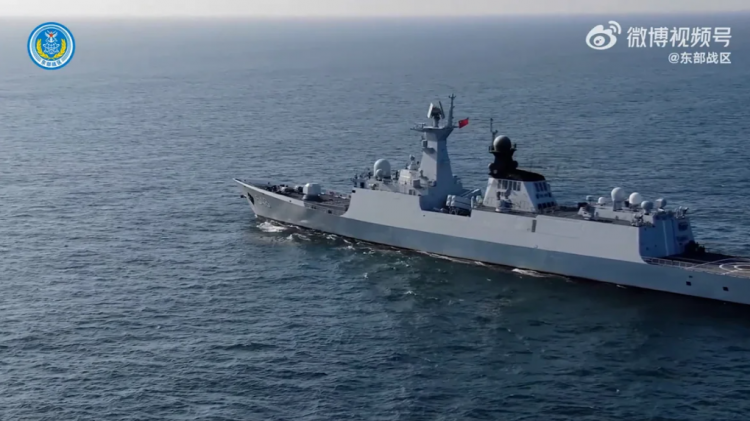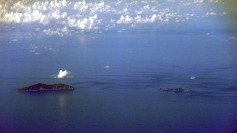China launched expansive military drills around Taiwan on Tuesday, deploying an aircraft carrier battle group and dozens of warplanes in a show of force intended as a "stern warning" against what Beijing calls separatist activities. The exercises-conducted by the People's Liberation Army's Eastern Theater Command-come amid deepening tensions with Taiwan's newly inaugurated President Lai Ching-te and just days after U.S. Defense Secretary Pete Hegseth completed a tour of Asia pledging to counter "China's aggression."
The joint maneuvers involve China's navy, air force, ground units, and rocket forces, covering waters and airspace to Taiwan's north, south, and east. "It is a stern warning and forceful deterrence against 'Taiwan Independence' separatist forces," the PLA said in a statement. "It is a legitimate and necessary action to safeguard China's sovereignty and national unity."
Taiwan's Defense Ministry reported detecting 71 Chinese military aircraft and 13 navy vessels around the island, including movements by the Shandong aircraft carrier group into its air defense identification zone. In response, Taipei dispatched aircraft and warships and activated land-based missile systems to track PLA maneuvers.
Taiwanese Defense Minister Wellington Koo called the drills an alarming disruption to regional order. "I want to say these actions amply reflect (China's) destruction of regional peace and stability," Koo said. Taiwan has established a central response group to monitor the situation and maintain readiness.
Beijing's Taiwan Affairs Office stated the operations were directly aimed at President Lai, accusing him of stirring "anti-China sentiments" and promoting "independence." "Lai Ching-te stubbornly insists on a 'Taiwan independence' stance," the office said in a statement, blasting his recently unveiled 17-point national security plan that includes heightened restrictions on Chinese immigration and reforms to handle espionage cases.
In a statement on X, Taiwan's Presidential Office said, "China's blatant military provocations not only threaten peace in the #Taiwan Strait but also undermine security in the entire region, as evidenced by drills near Australia, New Zealand, Japan, Korea, the Philippines & the SCS."
China's military activity comes as the U.S. shifts its strategic attention to the Indo-Pacific. During his trip to the region, Secretary Hegseth called Japan an "indispensable partner" in countering Chinese aggression and pledged to reinforce America's security pact with the Philippines. An internal Taiwanese government analysis cited Hegseth's visit as an external factor influencing China's military posture, saying Beijing is using Taiwan as a "pretext" to demonstrate resolve without directly confronting Washington ahead of expected trade talks.
China's Coast Guard also launched law enforcement patrols around the island, with exercises involving the interception of "unwarranted vessels." At the same time, the PLA released multiple propaganda videos, including a cartoon that portrays President Lai as a green parasite "poisoning" Taiwan-imagery Taiwanese officials described as dehumanizing and escalatory.
Zhang Chi, a professor at China's National Defense University, told CCTV that such exercises are becoming routine. "This largely indicates that the exercises we see today have become a new normal for the PLA and the Eastern Theater Command-it's routine for them."
Taiwan's National Security Council Secretary-General Joseph Wu condemned the drills as "reckless" and "irresponsible." He posted on X, "It came without justification, violates international laws and is totally unacceptable. Democracies need to condemn China for being a troublemaker."
In the Philippines, General Romeo Brawner Jr. said the military should prepare to evacuate over 250,000 Filipino workers from Taiwan in the event of a Chinese invasion. "If something happens to Taiwan, inevitably we will be involved," Brawner said during a ceremony for a regional command near Taiwan.
China has intensified its pressure campaign on Taiwan since 2016, when official communications between Beijing and Taipei were cut. Recent Chinese maneuvers have included simulations of a blockade, airspace incursions, and naval drills intended to test Taiwan's surveillance and response capabilities. In mid-March, China launched a similar large-scale exercise, sending ships and drones toward the island. The frequency and scale of these operations have led analysts to conclude they are both political signals and operational rehearsals.
Taiwanese experts say the element of surprise in Tuesday's exercises-launched without prior notice-marks a new phase in China's posture. "I think Beijing is trying to show its signal to Washington," said Su Tzu-yun of the Institute for National Defense Security Research in Taipei.
While no official end date for the exercises has been announced, regional observers believe the drills are designed to test multi-domain operations and assess how effectively the PLA can enforce a maritime and air blockade of the island in a crisis.
Taiwan and China split in 1949 following a civil war. While the island operates as a self-governed democracy, Beijing claims it as its territory and has vowed to reunify it with the mainland, by force if necessary. Most Taiwanese oppose unification and support maintaining their current de facto independence. Polls show strong support for preserving democratic governance and political autonomy.






